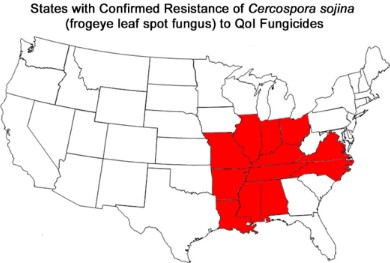By Jaime Cummings and Ken Wise
Frogeye leaf spot (FELS) is currently considered a minor foliar disease of soybeans in NY. This easy-to-identify leaf spot is caused by the fungus Cercospora sojina, and typically shows up mid- to late-season in random soybean fields. The disease gets its name from the similarity of the spots to what a frog’s eye looks like, having dark reddish-brown margins and light brown-gray centers (Fig 1). The lesions may be round or irregularly shaped. If you look closely with a hand lens, you may see the spores of the fungus in the center of the spots if it’s humid. These spores in the spots will be wind-dispersed to other leaves, resulting in multiple cycles of the disease in one season if the weather is conducive for infection.
Figure 1. Frogeye leaf spot foliar lesions on soybean leaves in Tompkins County 2019.
The FELS pathogen has multiple races (up to 20 known races!), which means that management with genetic resistance is race-specific. We do seem to have some highly virulent strains of the fungus in NY, and likely multiple races among those strains. That’s why you can see one soybean field with moderate to high levels of FELS across the road from another soybean field with little to no FELS. The genetic resistance available in some soybean varieties is quite effective, but only against specific races of the pathogen. However, there are soybean varieties available with resistance to all known races of FELS, though maybe not in early maturity groups that are planted in NY.
Figure 2. NY counties with known frogeye leaf spot occurrence 2012-2018 shaded in purple. More counties will be added when updated with 2019 observations.
FELS has typically been a sporadic pest in NY, rarely reaching epidemic levels that would require fungicide applications (Fig. 2). We’ve been fortunate that when it does appear, it typically shows up during later reproductive stages and will have little to no effect on yield or grain quality. But in recent years, this trend may be changing, and we may need to be more aware of FELS in NY soybean fields, and potentially consider management options.
Figure 3. Severe epidemic of frogeye leaf spot on a susceptible variety.
I’ve noticed FELS in more and more fields in NY over the past few years, and have had reports of moderate to severe outbreaks earlier in the season in fields planted with susceptible varieties (Fig 3.). FELS is considered one of the major foliar diseases contributing to yield losses in more southern latitudes in the US, causing 17,662,000 bushels lost nationally in 2015; second overall only to Septoria brown spot. Our NY yield losses to FELS have likely been minimal, but that could change as we see more FELS around the state each year. Yield loss from FELS is due to decreased photosynthetic capability of infected leaves and premature defoliation, along with a potential reduction in seed quality. For more information on estimated yield losses to soybean diseases, see this
publication by the
Crop Protection Network.
Figure 4. Life cycle of frogeye leaf spot fungal pathogen on soybean.
As FELS prevalence increases in NY, so does the local inoculum. The fungus can overwinter on soy residues, including shattered seeds, and can be seed transmitted (Fig. 4). Seed transmission can be mitigated via fungicidal seed treatments and purchasing high-quality, treated seed. Other good integrated pest management practices for reducing FELS in your fields include crop rotation, planting resistant varieties, and potentially foliar fungicide applications in severely infected fields. Should we get to the point where fungicides are needed to manage FELS in NY, there are a number of products available with ‘good’ to ‘very good’ efficacy ratings against this disease. And it is recommended to make protective fungicide applications between R2-R5. See
this table from the Cornell Guide to Integrated Field Crop Management for available fungicides. However, it is worth noting that fungicide resistance has been well-document to some quinone outside inhibitor (QoI) group (FRAC group 11) fungicides among numerous FELS fungal populations in at least 13 states (Fig 5). For more information on fungicide resistance in soybean pathogens, visit this
site.

Figure 5. Documentation of fungicide resistant populations of frogeye leaf spot pathogen as of 2016.